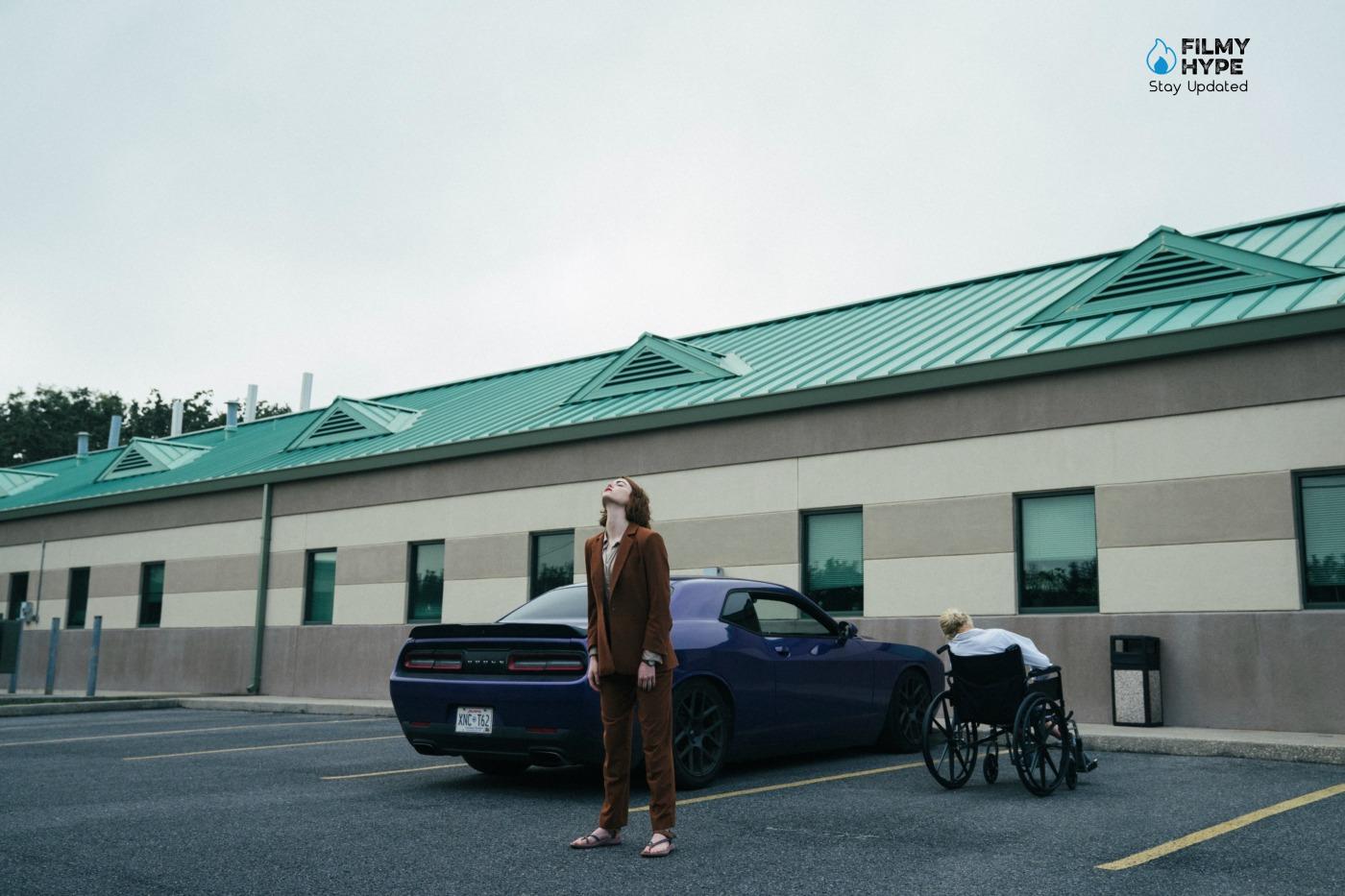Kinds of Kindness Ending Explained: Who is RMF? Meaning and Explanation of the Ending?
Kinds of Kindness Ending Explained: A few months after the incredible success of Poor Things, Yorgos Lanthimos is back. Kinds of Kindness is a new, crazy, and surreal film by the Greek filmmaker. Three films in one. It is an anthology work, in which each of the cast members plays different characters in the stories that follow one another. Three self-contained stories, medium-length films that are detached but at the same time very similar to each other. The anthological structure of the film opens up to different interpretations. There are many questions raised by Lanthimos that are not answered during the film. If you haven’t seen it yet, here is our review of the film. Otherwise, we are ready to answer your questions: here is the definitive explanation with spoilers of Kinds of Kindness.

Divided into three self-contained stories, the cast includes many actors and actresses who have already worked with Greek directors, especially Emma Stone and Willem Dafoe. Despite its three-hour duration, it is a film that brings Lanthimos back to his debut, with a very different style than that of Poor Things. The director returns to the purest and most bizarre form that we have found in his previous works. And even if it will divide the audience quite a bit, Kinds of Kindness shows us a mirror of reality that is nothing short of disturbing, with a courageous script, determined to show the dismay that comes from the obsessive search for something that might resemble love.
Kinds of Kindness Review: The Story Plot
Kinds of Kindness is an anthology film, a sort of trilogy of three medium-length films, united by the use of the same actors in different roles and the character of RMF, always evoked in the title. The protagonists of the three stories are Emma Stone and Jesse Plemons, dealing with a hat trick of controversial and sticky characters. In the first story, Plemons decides to say no to a single request from Raymond (Willem DeFoe), the man who has dictated his existence for ten years, sending him an autographed note every day with precise instructions on what to wear, what to eat, at what time go to sleep, whether to have sex with his wife or not.
In the second story, Plemons is a policeman whose wife has been missing for days, after the shipwreck of the scientific expedition of which the woman was part. When Liz (Emma Stone) returns, her husband is certain that the woman in front of her is not her wife and tries to exploit the blind loyalty of what she believes to be a scammer to unmask her. In the third episode, the two interpreters are the envoys of a bizarre sect that is looking for a woman capable of resurrecting people. Members of the community are asked to drink only water purified by the two founders and to abstain from romantic relationships with anyone other than Omi and Aka, the holy men of the sect.
Yorgos Lanthimos with Kinds of Kindness offers his usual disturbing, grotesque cinema, embellished with dark humor and a mocking tone which however go in tandem with restlessness, an amused but cynical vision of society, man, and his nature. Three episodes written together with Efthimis Filippou with a total duration of almost three hours, which in the end have weight, so much so that one wonders if the structure chosen by the Greek director was the right one. Lanthimos was the winner at the last Venice and at the recent Oscar night, but this is an ontological cinematographic project that takes him back to the times of The Lobster, Dogtooth, and even The Favorite but not as much as would have been needed. Margaret Qualley, William Dafoe, Joe Alwyn, Mamoudou Athie, Hunter Schafer, and Hong Chau support the two, Jesse Plemons and Emma Stone. They are always at the center, always the driving force, always chameleonic in a charming, graceful, and effective way, as they outline different shades of perversion, human toxicity, control mania, and hypocrisy.

And following in their footsteps, we find ourselves tossed among homages to slapstick comedy, the glamorous cinema of the 80s, and much more. The first episode of Kinds of Kindness is connected to a rich businessman (Dafoe) who controls every shred of the existence of his subordinate (Plemons), repaying him with wealth, and exclusive gifts, with which to fuel a homoerotic toxic relationship. But an unusual request will put that unstable relationship in danger. In the second, a policeman (Plemons) is on the verge of a nervous breakdown over the fate of his wife (Stone), reported missing during a scientific expedition at sea.
However, when she is saved and returns home, he no longer recognizes her, she thinks that she has been replaced by a lookalike, and a sort of absolutely crazy psychological war will begin between the two of her. We then arrive at the third, a sect halfway between New Age and Sexmania, with two members (Plemons and Stone) tasked by the Guru (Dafoe) with looking for a possible messiah, capable of resurrecting the dead. The three episodes have nothing in common, yet have a lot in common, when they tell us about unspeakable desires, asociality, difference from the norm, selfishness, and above all the total absence of empathy. But the final result is certainly less successful, less daring than what one might expect from the usually so-surprising Greek filmmaker.
Kinds of Kindness Ending Explained: The Meaning of the Title
The first enigma to solve when talking about Kinds of Kindness is the title itself, which can be translated as “Types of Kindness”. Acts of kindness, in reality, are seen very few throughout the film. Kinds of Kindness is an ironic title, which however contains in its sarcasm a multitude of meanings. It wants to refer to how people “are kind to each other”, where kindness refers to the gestures made by the two macro-categories into which it is possible to divide the characters of the film: abusers and abused.

The former show their supposed kindness with gifts (be they sports memorabilia, money, or sanctified water), but above all by imposing their control, making it seem like they are doing everything for the good of the other. On the other hand, those on the opposite side are called to demonstrate their love. In this case, the act of kindness consists of sacrificing part of oneself, of one’s body or soul, to repay the debt of “love and kindness”. The title Kinds of Kindness therefore alludes to the human, emotional, and social relationships that are the basis of the film. But the plurality of meanings that can be given to it also recalls the structure of the film. A deliberately ambiguous title to accentuate the narrative and stylistic variety. It is no coincidence that the film was originally supposed to be called AND. A simple conjunction that would have served to symbolize the link between different elements, or the three stories of the film. Even before that, however, the planned title was RMF.
Kinds of Kindness: Who is RMF?
RMF are the initials of the only character present in all three parts of Kinds of Kindness. It is a simple narrative device (called “McGuffin” in slang). RMF acts as a glue between the various stories, giving a sense of continuity to the narration. If in the first story, he dies at the hands of Robert (Jesse Plemons), in the last one he is brought back to life, giving a certain circularity to the story. The only detail that raises some doubts is his presence in the second act, where he plays the role of Liz’s (Emma Stone) rescuer. However, we can assume that the three stories are not presented in chronological order, and therefore all the characters in the film share the same narrative universe, even if played by the same actors (which subconsciously helps the viewer to find analogies between the various characters).
Regardless, what matters is the thematic connection between the stories. Each of them speaks of faith, power, control, and everything that concerns human dynamics. A working and loving relationship in the first act, a marital one in the second, and a religious-social one in the third. In all of them, we ask ourselves how far we can go for love, to feel loved and accepted by others. And above all, it is about freedom and free will. The protagonists oscillate between the possibility of deciding for themselves and succumbing to others. When they come into total control of their lives, they decide to give it up again. In the first story, for example, the character of Plemons, once free from Raymond’s dominion, is unable to decide what to order at the bar, entrusting his choice to the waiter, who advises him and serves him white wine. In the second act, Emma Stone’s Liz has regained her life after a shipwreck on a desert island. Yet, she decides to do without it in the face of her husband’s perplexity.
The Death of RMF?
In the first story, Robert (Plemons) is a man whose life is minutely controlled by Raymond (Willem Dafoe), with whom he also has a relationship. He dictates what he does at every hour of the day: how much and what to eat, what to read, and much more. The situation degenerates when Raymond asks Robert to kill a man, who as the title suggests is none other than RMF. After Robert’s rejection, he finds himself having to start his life over from scratch. Raymond instead turns his attention to a woman, Rita (Emma Stone). When Rita ends up in the hospital after unsuccessfully trying to kill RMF; Robert decides to retrace his steps. The first act ends with the protagonist brutally killing RMF by running him over with his car a couple of times. Robert then returns to Raymond, who admits that he never doubted him. The ending symbolizes Robert’s obsession, unable to take control of his life but needing to be accepted by Raymond. He understands that he cannot do without his control, also driven by the awareness that he is not irreplaceable.
RMF is Flying!
This second tale in Kinds of Kindness is the most difficult to decipher and opens up many theories. Here Plemons plays Daniel, a policeman whose wife disappears after a shipwreck. When Rita (Emma Stone) is rescued and returns home, Daniel begins to believe that she is not his wife. Numerous clues lead Daniel to this conclusion. Some of Rita’s habits change she starts eating chocolate which she previously hated, and smoking a cigarette, which she had never tried. Even her shoes don’t fit perfectly. Daniel’s suspicions and madness reach their peak when Rita confesses to him that she is pregnant. Daniel refuses any form of food until he makes some special requests to his wife. First, he asks her to cut off a finger from her hand and serve it to him cooked. Having done this, he beats Rita to the point of causing the loss of the child (as can be deduced from Rita and Daniel’s dialogues with their respective doctors); Daniel asks his wife to cook him some liver. As before, Rita decides to please her husband by removing the liver from her body and thus losing her life. Immediately after, someone rings the doorbell. Daniel opens the door to find his wife in front of him, whom he warmly embraces.

Rita’s arrival symbolizes the reunion between Daniel and his wife, who by taking her own life shows all her “love”, or rather her emotional dependence. In this way, on the one hand, one can think that Daniel finally understands that she is his real wife. On the other hand, however, the clues scattered throughout the film are never completely refuted: for example, Daniel continues to receive calls with poor reception (as if the caller were on a desert island). However, Liza’s swollen feet and the change in eating and sexual habits would be clearly justified by the pregnancy and the shocking experience of the shipwreck. In short, Lanthimos does not want to close the door to any hypothesis, not even the surreal one of the existence of a clone of Liz. However, everything suggests that the final embrace is purely metaphorical and partly the result of Daniel’s growing madness. Certainly, just like in the first act, we have a crazy gesture of love and submission, which leads the protagonist to deprive herself of her own life to reconcile with her beloved.
This story also includes a dream, in black and white, which is particularly significant for understanding the film: the one about dogs. Here the relationship between master and animal is highlighted, which in real life takes on the characteristics of dominator and dominated. The dogs in the dream leave the men some chocolate (which they cannot eat) and keep the foods they are greedy for for themselves. Yet Liz claims that they treat men well. Just like the abusers in Kinds of Kindness who delude their “victims” into thinking they are doing them good, leading them to depend on their control in morbid and toxic relationships.
RMF Eats a Sandwich!
The protagonist of the third act is Emily (Emma Stone), who after abandoning her husband and daughter to follow a religious cult based on sex, water, and purity; is searching on behalf of this sect, for a woman with thaumaturgical powers who would become its spiritual leader. When Emily is the victim of sexual violence by her husband, she is expelled from the sect, because “contaminated”. The woman understands that the only way to be forgiven and readmitted is to find the girl she is looking for. However, she must meet certain requirements: her weight and body measurements, the fact that she is the only one of two twins who has survived, and the ability to heal and bring living beings back to life.
Emily is approached by Rebecca, one of the twins played by Margaret Qualley (Drive Away Dolls, Once Upon a Time in Hollywood). Rebecca tells Emily that she miraculously survived after falling into an empty swimming pool. She is convinced that her sister, the veterinarian Ruth, is the girl Emily is looking for. Emily had previously dreamed of being saved by Rebecca after sinking in a swimming pool. Emily is convinced when, by bringing Ruth an injured dog, the wound heals. However, Ruth does not meet all the requirements to be the chosen one, since her sister is still alive. Rebecca then decides to take her own life, before Emily’s eyes, by diving into an empty swimming pool. At this point, the woman forcibly takes Ruth to a morgue to subject her to the decisive test. Here the corpse to be resuscitated is precisely that of RMF. The girl, by bringing her hand close to the victim’s body, brings her back to life.
Then the famous Emma Stone dance scene takes place to the tune of Brand New Bitch, in a moment of ecstasy for her character. Although the credits of this third segment of the film start to roll, the story does not have a happy ending. On the way home, Emily has a car accident that costs Ruth her life. All the sacrifices of Emily and Rebecca are therefore revealed to be useless. This third act also deals with the concept of freedom. When Emily is expelled from the sect and regains free will, she decides not to use it to start over, free from the constraints imposed by religious worship but rather demonstrates her unhealthy attachment to the precepts of the sect. Last but not least, if you were wondering why the story is titled “RMF Eats a Sandwich”, the answer is in the post-credit scene designed by Lanthimos. Right after the credits of Kinds of Kindness, RMF is seen getting his initials on his shirt dirty, while eating a sandwich.
The Endings of the Three Stories Explained?
The first story is about a man (Plemons) controlled in everything he does by Raymond (Dafoe): he tells him what to do, when, and what to eat, and he dictates the time and the choices. At a certain point, he orders him to kill a man (RMF, precisely). The protagonist refuses, but when he realizes that he cannot be independent on his own, he does what Raymond asks him to do just to be accepted by him. The second story is more “open”. Here Plemons plays a policeman: when his wife disappears in a shipwreck and then returns home, he doubts it is her. Liz (Stone) changes habits, she is strange, until he asks her to cook his liver.
She tears it out of her body and then dies. A woman knocks on the door and tells him that she is really his wife. Here Liz’s sacrifice symbolizes his emotional dependence, but the director continually misleads us by never revealing who Daniel’s real wife was. The third story is about a woman who abandons her husband and daughter to join a religious sect. When she is the victim of sexual violence, she is expelled because she is “contaminated”. She does everything she can to be forgiven, but her sister loses her life. Here Lanthimos addresses the concept of freedom: when the protagonist is expelled from the sect, she regains free will, but she does not use it to start over, but rather to demonstrate her toxic attachment to the sect itself.






